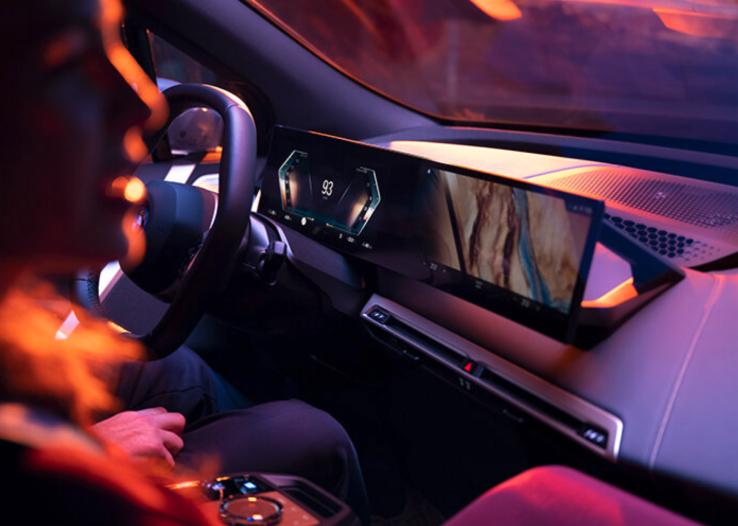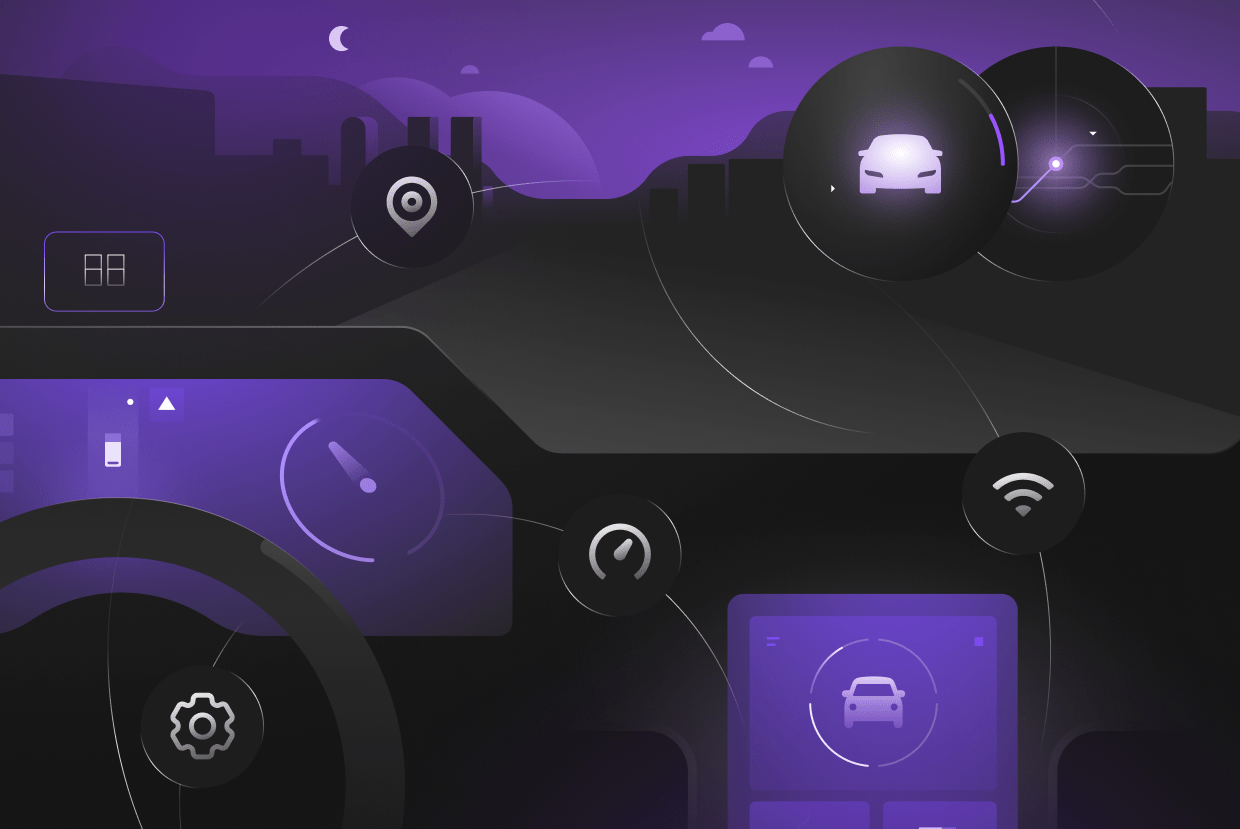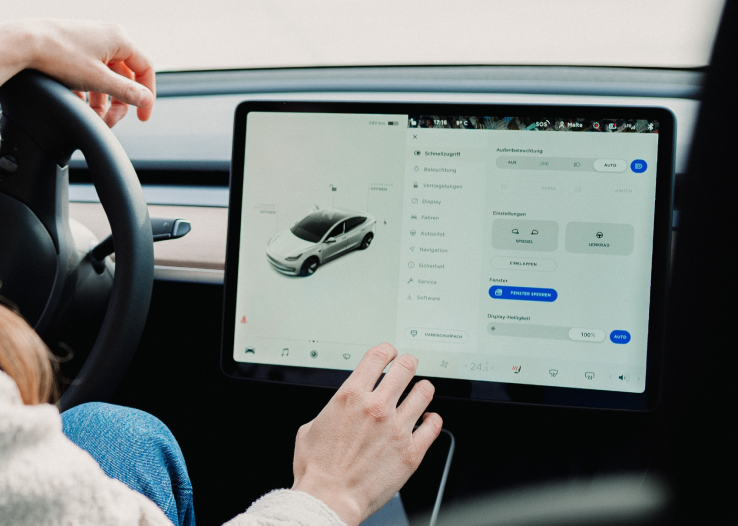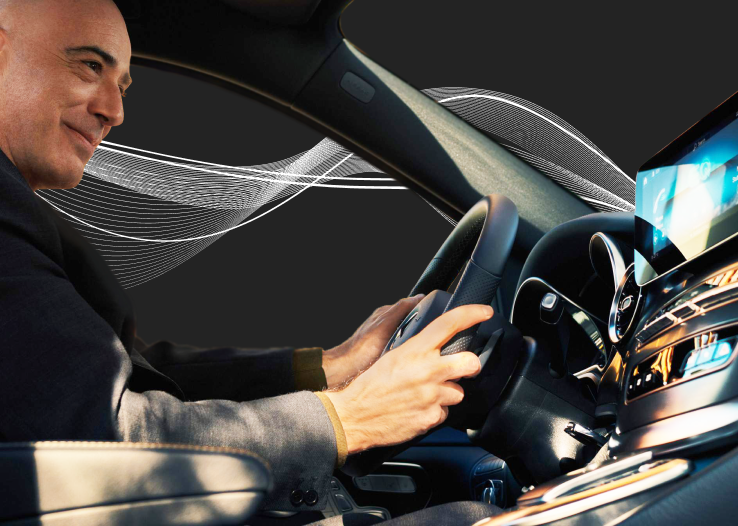The following article is based on our recent masterclass, "Rethinking automotive HMI in the age of agentic AI" which is available on-demand here.
Vehicles are evolving from transportation tools into intelligent, adaptive companions. That means the way we interact with them needs to evolve too. Traditionally, in-car HMIs were built around static menus, buttons and voice commands. But now that’s giving way to dynamic, context-aware systems powered by agentic AI — autonomous AI agents that observe, reason, act and evolve, rather than simply respond to predefined rules.
Agentic AI isn’t just a technological shift — it’s a design shift. The real challenge is not building smarter systems, but designing the right relationships between humans and intelligent machines
These new interfaces don’t just respond to drivers. They anticipate needs, negotiate tasks and learn preferences over time. Rethinking automotive HMI in the agentic AI era isn’t about redesigning dashboards, it’s about redefining the relationship between drivers and their vehicles to create a compelling customer experience.
Agentic AI in customer experience
When it comes to automotive and mobility markets, customer experience (CX) is the differentiator. With vehicles becoming software-defined, service-oriented and fused into broader mobility ecosystems, the interface between driver and machine has become the primary locus of brand value, loyalty and differentiation.
The global automotive AI market is projected to hit $48 billion by 2034, highlighting the growing weight of software, algorithmic intelligence and interactive design in what vehicles offer. They’re no longer just a mode of transport but a holistic digital experience.
This shift from user interface (UI) to experience (UX) to intelligent relationships is made possible by agentic AI.” Agentic AI denotes AI systems capable of pursuing goals autonomously, making decisions, interacting with environment and humans and learning over time.
For OEMs, this represents a trigger event in HMI design. No longer is it restricted to statically presenting content or reacting to voice commands but enabling systems that actively anticipates needs, handles complexity and increases personalization.
CX is the differentiator because users are no longer accepting “good enough” interfaces. They demand systems that feel intelligent, responsive, personalized and seamless. Agentic HMI is the mechanism to deliver that experience.
How is AI driving in-vehicle UX?
The following timeline — flowing from "not so long ago" to "what's coming on the horizon" — highlights the shift from “driver tells the system what to do” to “the system partners with you to achieve outcomes”.
1. Before AI
Rule-based systems
- How it works: Rule-based
- What it does: Follows predefined paths (menu navigation or scripted commands)
- Boundaries: Isolated systems
- Impact: Predictable but rigid; user controls every step
2. AI assistants
Automating repetitive tasks
- How it works: Reactive
- What it does: Executes commands
- Boundaries: Single system
- Impact: Faster operation; still manual
3. AI agents
Goal-orientated automation
- How it works: Goal orientated
- What it does: Plans actions
- Boundaries: Closed/one domain
- Impact: Delegation instead of operation
4. Agentic AI systems
Autonomous orchestration, multi-agent
- How it works: Proactive and collaborative
- What it does: Coordinates agents and services
- Boundaries: Cross system / connected
- Impact: Coordination instead of control
For in-vehicle UX that means the HMI moves beyond menus and voice prompts into a domain where the system anticipates likely next-steps, handles mundane tasks, surfaces relevant information at the right time and adapts to driver (or passenger) preferences.
This has an incremental effect on business too. McKinsey & Co research predicts that agentic AI could generate $450 - 650 billion in additional annual revenue by 2030 across the automotive industry.
Thus the revolution in vehicle UX is not simply incremental, it’s structural.
What are the benefits of agentic HMI?
Agentic AI drives four major opportunity areas for HMI design. Below we explore each with illustrative use-cases. Together they show how agentic HMI can radically elevate the vehicle UX from generic to bespoke.
Seamless digital experiences
Consumers expect digital continuity across their devices, contexts and modes (mobile, vehicle, home, work) and agentic HMI enables seamless transitions.
Imagine a user (let’s call her Anna) stepping into her vehicle and the system already knowing her schedule, preferred route to work, cabin climate settings, favorite playlist, and proactively setting up the environment, navigation and meeting reminder. It can even select a coffee stop en route.

By acting as a proactive assistant embedded in the vehicle ecosystem, the system bridges digital and physical worlds, reducing friction and making transitions fluid and elevating the user experience.
Hyper-personalization
Personalization and individualism is one of the core HMI trends. Deep personalization becomes feasible when agentic HMI systems continuously learn user behavior, preferences and context — and then adjusts accordingly.
Anna’s system learns she likes soft jazz in the morning commute, a colder cabin at 18°C and prefers avoiding toll roads. Over time, agentic HMI tailors suggestions, proactively reminds her of maintenance and adapts to her calendar even mood inferred from voice or posture.

Here the car becomes less of a machine and more of a personal mobility assistant.
Superhuman capabilities
Agentic HMI enables capabilities beyond human cognitive and physical limits. For example, predictive safety interventions, system-wide analytics, anticipatory maintenance, seamless human-machine handoff (driver to vehicle and back), voice-and-gesture control and ambient AI weaving together sensors, camera, infotainment and external data.
According to Salesforce, 56% of car owners believe AI agents will simplify car maintenance and 70% said they would use an AI agent if it meant real-time diagnostics. In the context of the vehicle, this translates to faster diagnostics, automated route optimizations, real-time risk predictions and seamless over-the-air updates without driver intervention.

Users essentially get “superhuman” support because the system augments their capabilities rather than merely enabling them.
Human-like support
Finally, agentic HMI offers more natural, human-like interaction frameworks including ongoing dialogues, proactive suggestions, emotional understanding, multi-modal language, voice and ambient intelligence.
For example, Anna asks “Will we get to the airport on time?” The system responds “We’re slightly behind. I’ve selected an alternative route.” Now the agent has become a conversational partner, not just a command receiver.

This human-machine partnership creates trust, engagement and sense of agency.
Agentic AI challenges for HMI
While opportunities are plenty, realizing them at scale in vehicle context presents serious challenges across user, technical and business dimensions. Collectively, these critical challenges require an interdisciplinary lens consisting of only software-engineering, UX design, data governance, brand experience and business strategy.
1. Loss of user control
As systems become more autonomous, users might feel a loss of control or agency. If the vehicle “does things for me” without clarity, it could cause drivers to feel disempowered or distrustful.
How to solve it: Provide transparent controls, allow seamless hand-off between human and agent, expose rationale (“why did I get this suggestion?”) and allow opt-in/opt-out of agent behaviors.
2. Technical misunderstandings
When agents act in complex, real-world contexts any misunderstanding or mis-interpretation can cascade into unintended consequences. Agentic AI systems are more unpredictable than rule-based ones. A recent Cornell review highlights that current evaluation frameworks for agentic AI are heavily weighted to technical metrics but neglect human, safety and economic dimensions.
How to handle it: Build robust simulation and use human-in-the-loop supervision. Continuous monitoring, fallback modes, clear escalation paths and real-world feedback loops all add a layer of safety.
3. User privacy & trust
Agentic HMI relies on vast data streams like user preferences, voice, location, habits, etc. This raises privacy, consent and trust issues. If users mistrust the agent (or by extension the brand), then its value collapses.
How to handle it: Define transparent data governance and usage, design clear opt-in flows for personalization, provide security of on-vehicle and cloud systems and establish brand trust by emphasizing human-agent partnership rather than full automation.
4. Environment & cloud dependence
Vehicles operate in dynamic, edge-heavy contexts (connectivity fluctuations, sensors, latency, offline mode). Agentic HMI mainly relies on cloud services or real-time updates, meaning a disrupted network or outdated model could reduce performance or safety.
How to handle it: Design hybrid edge-cloud solutions, fallback modes, offline agentic capabilities and make sure update mechanisms are secure and connectivity-resilient.
5. Brand differentiation & scaling
With many OEMs jumping to add “AI assistants” and “intelligent cabins” there’s a risk of commoditisation. Meaning, agentic AI features then become table-stakes, not actual differentiators.
On top of this, scaling agentic HMI across global fleets, hardware variations and software-defined vehicles is complex and can lead to “agent washing” — Gartner research claims that only about 130 of the thousands of agentic AI vendors are actually real.
How to handle it: Define clear business value upfront, choose use-cases with high brand impact, build scalable software-defined architecture and design flexible ecosystems (apps and services) rather than one-off features.
How to navigate HMI in the agentic AI era
Success in the agentic AI era relies on OEMs and suppliers having an HMI development framework that spans multiple dimensions. Instead of, “can we build this agent?” think, “is it valuable, desirable, feasible, compliant?” Using the Star Lens, a five-dimension framework tailored to Agentic HMI innovation, can help here:
- Valuable – Does the feature deliver clear user value and business ROI?
- Viable – Is the business case sustainable? Can it scale across models, regions, hardware tiers and services?
- Desirable – Will users embrace the experience? Does it feel intuitive, trustworthy and delightful rather than odd or complex?
- Feasible – Can the system be implemented with available sensors, data pipelines, software-defined vehicle architecture and update mechanisms?
- Compliant – Does it meet safety regulations, data-privacy laws, cybersecurity standards and brand commitments requirements?

By evaluating proposed Agentic HMI features across all five dimensions, OEMs can avoid building “cool demos” that don’t scale, delight or differentiate, and instead focus on interventions that truly elevate CX and brand value. For example: when designing a “proactive travel-assistant” agent, you might ask:
- Valuable: Does it reduce user cognitive load or travel stress?
- Viable: Can it be deployed across global markets with local traffic-data integration?
- Desirable: Do users feel comfortable letting the agent plan for them?
- Feasible: Do we have the data, connectivity and sensor fusion required?
- Compliant: Are we capturing and storing user calendar data in line with GDPR?
Through iterative prototyping, user research and ecosystem alignment, the Star Lens helps convert emergent agentic AI capabilities into viable vehicle-UX differentiators.
The convergence of intelligent vehicles, data-driven services and user expectations means that CX is now the main differentiator and agentic HMI is the enabler. By shifting from rule-based systems to agentic AI platforms, OEMs can re-imagine the in-vehicle experience as seamless, personalised, superhuman and human-like.
For OEMs ready to deliver experiences that matter, explore how Star designs, tests and scales digital services that customers truly value.











